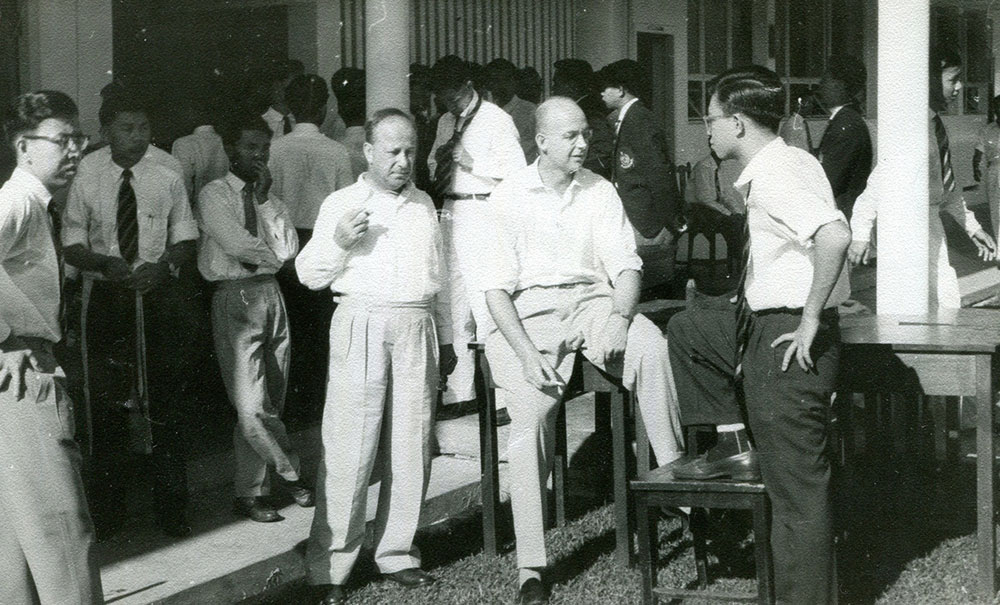
Poelzig’s Legacy and the Prefab in the Tropics: German Influences in Southeast Asia
(German text below / Deutscher Text unten)
This part of the exhibition aims for the first time to assess planning and building activities that took place with German participation in Southeast Asia from the 1950s to the 1970s. Architects, engineers, companies, and state-owned enterprises of both the German Democratic Republic (East Germany) and the Federal Republic of Germany (West Germany) were active in the region.
In South Vietnam, for example, West Germany supported the USA by providing humanitarian and developmental aid, building hospitals, “children’s villages”, and vocational training centres for young people. East Germany, on the other hand, was more active in the north of Vietnam, especially after the end of the war in 1975.
In 1955, West Germany adopted the Hallstein Doctrine, seeking to prevent other countries from conducting diplomatic relations with East Germany. Myanmar chose to disregard the policy and instead built bilateral relations with both East and West Germany, receiving developmental aid for civilian as well as military purposes. In 1965, for example, East Germany sold arms to the military junta. Already in 1953, the West German company Fritz Werner, which was nationalized in 1965, was active in Myanmar with a large number of civilian and military projects until 1988, and both directly and indirectly supported the military dictatorship of General Ne Win.
With projects in Indonesia, Singapore, and Cambodia, both German states also sounded out markets for their products, often competing with established networks by the former colonial powers.
Commissioned by the colonial power Great Britain, the German-born exiles Julius Posener and Vernon Z. Newcomb (born as Werner Zunz) established Malaysia’s first architectural department and the Federal Housing Trust, respectively, in Kuala Lumpur. Influenced by architects such as Hans Poelzig, Max Bill, Le Corbusier, and Walter Gropius, the instructors that were recruited, among them the German architect C. W. Voltz, advocated the adaptation of universal, modernist concepts to the local climate and lifestyles of the population.
There is much more to learn about the architectural legacy of East and West Germany’s involvement in the region, which could shed light on the political, social, and cultural assumptions in colonial and postcolonial times that shaped notions of progress and civilization underpinning policies of socialist solidarity and development aid.
More recently, the military coup in Myanmar in February 2021 reveals highly problematic aspects of German involvement and raises questions about Germany’s long-term responsibilities in the region.
Curated by:
Sally Below, Moritz Henning, Christian Hiller, and Eduard Koegel
Advice on East Germany’s architectural exports was provided by Andreas Butter, who, together with Christoph Bernhardt and Monika Motylinska conducted research on this topic at the Leibniz Institute for Spatial Social Research (IRS) in Erkner.
Christina Schwenkel contributed to the presentation on the city of Vinh, Vietnam.
Poelzigs Erbe und die Platte in den Tropen: Deutsche Einflüsse in Südostasien
Kuratiert von Sally Below, Moritz Henning, Christian Hiller, und Eduard Koegel
Dieser Teil der Ausstellung versucht zum ersten Mal eine Bestandsaufnahme planerischer und baulicher Aktivitäten mit deutscher Beteiligung in einigen Ländern Südostasiens von den 1950er bis in die 1970er Jahre. Architekten, Ingenieure, Unternehmen und Volkseigene Betriebe der Deutschen Demokratischen Republik und der Bundesrepublik Deutschland waren in der Region aktiv.
In Südvietnam beispielsweise arbeitete die Bundesrepublik auf Seiten der USA in der humanitären Hilfe. Mit Hospitälern, Kinderdörfern und Ausbildungsstätten für Jugendliche wollte man einen Beitrag zum Aufbau des Landes leisten. In Nordvietnam engagierte sich die DDR, vor allem nach dem Ende des Krieges 1975. Bereits in den 1950er-Jahren ignorierte Myanmar die westdeutsche Hallstein-Doktrin, mit der die diplomatische Anerkennung der DDR durch Drittstaaten verhindern werden sollte. Man kooperierte mit beiden deutschen Staaten, nicht nur im zivilen Bereich. So verkaufte 1965 die DDR Waffen an die Militärjunta. Ab 1953 schon war die 1965 verstaatlichte westdeutsche Firma Fritz Werner mit einer Vielzahl von zivilen und militärischen Projekten bis 1988 in Myanmar aktiv und unterstützte direkt und indirekt auch die Militärdiktatur von General Ne Win.
Mit Projekten in Indonesien, Singapur und Kambodscha loteten beide deutschen Staaten auch Märkte für ihre Produkte aus, die oft in Konkurrenz zu etablierten Netzwerken vormals kolonialer Mächte standen.
Im Auftrag der Kolonialmacht Großbritannien bauten die deutschstämmigen Exilanten Julius Posener oder Vernon Z. Newcomb (Werner Zunz) in Kuala Lumpur die erste Architekturausbildung bzw. den Federal Housing Trust in Malaysia auf. Beeinflusst von Hans Poelzig, Max Bill, Le Corbusier und Walter Gropius versuchten die Lehrenden, zu denen auch der Deutsche C.W. Voltz gehörte, eine Haltung aufzubauen, mit der universelle Konzepte an das Klima und die Lebensweisen der Bevölkerung angepasst werden sollten.
Das architektonische Erbe des deutsch-deutschen Engagements in der Region bedarf noch weiterer Forschung, die im historischen Rückblick auch über das politische, gesellschaftliche und kulturelle Selbstverständnis kolonialer und post-kolonialer Haltungen berichten kann, die hinter den Begrifflichkeiten der sozialistischen Solidarität oder der Entwicklungshilfe problematische Fragen zum Verständnis von Fortschritt und Zivilisierung aufwerfen.
Nicht zuletzt rücken mit dem erneuten Militärputsch in Myanmar im Februar 2021 auch die überaus problematischen Aspekte deutschen Engagements und damit die Frage nach einer nachhaltigen Verantwortung Deutschlands in der Region exemplarisch in den Fokus.
Kuratiert von:
Sally Below, Moritz Henning, Christian Hiller und Eduard Koegel
Andreas Butter, der zusammen mit Christoph Bernhardt und Monika Motylinska am IRS in Erkner zum Architekturexport der DDR geforscht hat, hat uns zu diesem Aspekt beraten.
Für die Präsentation von Vinh hat uns Christina Schwenkel geholfen.
